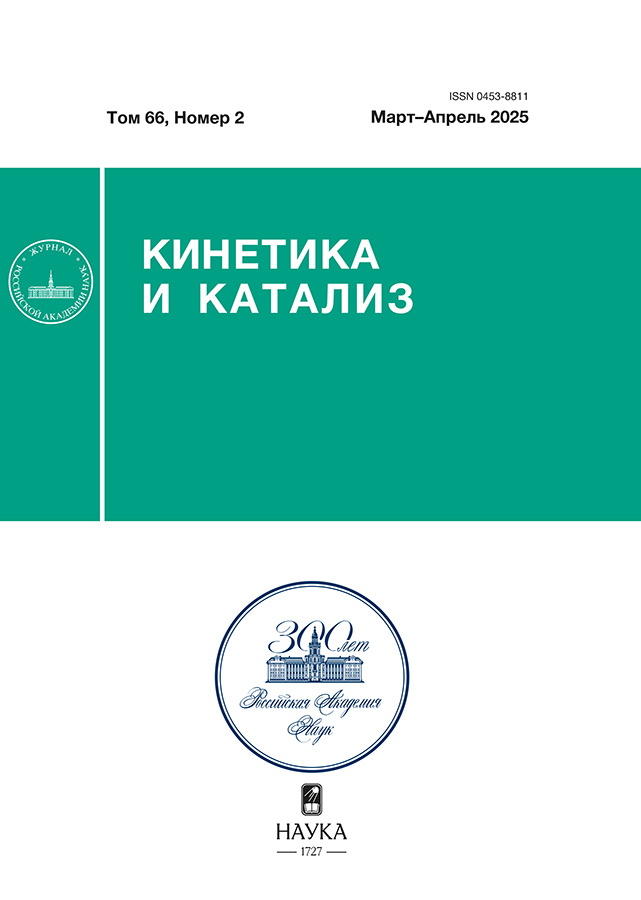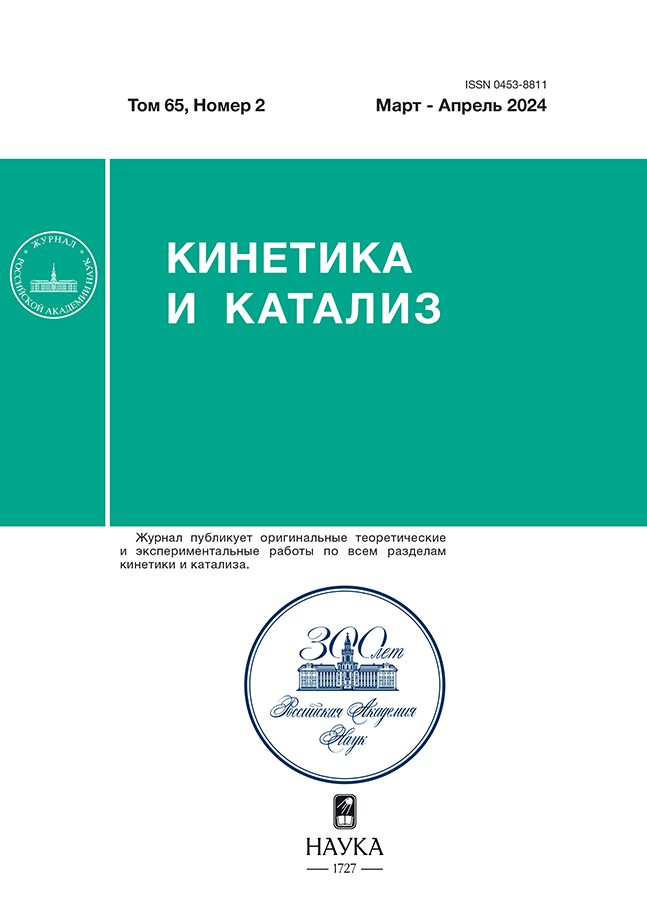Установление кинетических закономерностей фотокаталитического генерирования водорода из муравьиной кислоты на металлокерамических композитах при облучении видимым светом
- Авторы: Скворцова Л.Н.1, Артюх И.А.1, Татаринова Т.В.1, Болгару К.А.2
-
Учреждения:
- Национальный исследовательский Томский государственный университет
- ФГБУН Томский научный центр СО РАН
- Выпуск: Том 65, № 2 (2024)
- Страницы: 125-136
- Раздел: СТАТЬИ
- URL: https://stomuniver.ru/0453-8811/article/view/660327
- DOI: https://doi.org/10.31857/S0453881124020039
- EDN: https://elibrary.ru/DXQWEP
- ID: 660327
Цитировать
Полный текст
Аннотация
Изучены процессы фотокаталитического получения водорода из водных растворов муравьиной кислоты при облучении видимым светом с применением танталсодержащих металлокерамических композитов на основе нитрида кремния, приготовленных методом автоволнового горения в азоте ферросиликоалюминия (ФСА) и смеси порошков кремния и алюминия с добавками тантала, в отсутствие и с добавкой пероксида водорода в зависимости от концентрации субстрата и рН суспензии. Установлено, что зависимость скорости фотокаталитического получения водорода от концентрации муравьиной кислоты без пероксида водорода подчиняется механизму Ленгмюра–Хиншельвуда. В присутствии пероксида водорода при увеличении концентрации муравьиной кислоты наблюдается резкое увеличение скорости фотокаталитического процесса. Наибольшая скорость выделения водорода из муравьиной кислоты зафиксирована на железосодержащем композите, синтезированном из ФСА, без добавки пероксида водорода и составляет 4.55 мкмоль/мин.
Полный текст
Об авторах
Л. Н. Скворцова
Национальный исследовательский Томский государственный университет
Автор, ответственный за переписку.
Email: lnskvorcova@inbox.ru
Россия, просп. Ленина, 36, Томск, 634050
И. А. Артюх
Национальный исследовательский Томский государственный университет
Email: lnskvorcova@inbox.ru
Россия, просп. Ленина, 36, Томск, 634050
Т. В. Татаринова
Национальный исследовательский Томский государственный университет
Email: lnskvorcova@inbox.ru
Россия, просп. Ленина, 36, Томск, 634050
К. А. Болгару
ФГБУН Томский научный центр СО РАН
Email: lnskvorcova@inbox.ru
Россия, просп. Академический, 10/3, Томск, 634055
Список литературы
- Jamali-Sheini F., Cheraghizade M., Yousefi R. // Solid State Sci. 2018. V. 79. P. 30. https://doi.org/10.1088/1361-6641/ab0723
- Acar C., Dincer I., Naterer G.F. // Int. J. Energy Res. 2016. V. 40. № 11. P. 1449. https://doi.org/10.1002/er.3549
- Markovskaya D.V., Kozlova E.A., Stonkus O.A., Saraev A.A., Cherepanova S.V., Parmon V.N. // Int. J. Hydrogen Energy. 2017. V. 42. № 51. P. 30067. https://doi.org/10.1016/j.ijhydene.2017.10.104
- Pilemalm R., Pourovskii L., Mosyagin I., Simak S., Eklund P. // Condens. Matter. 2019. V. 4. Р. 36. https://doi.org/10.3390/condmat4020036
- Журенок А.В., Марковская Д.В., Потапенко К.О., Сидоренко Н.Д., Черепанова С.В., Сараев А.А., Герасимов Е.Ю., Козлова Е.А. // Кинетика и катализ. 2023. Т. 64. № 3. С. 276. https://doi.org/10.31857/S0453881123030139
- Kumaravel V., Mathew S., Bartlett J., Pillai S.C. // Appl. Catal. B: Environ. 2019. V. 244. P. 1021. https://doi.org/10.1016/j.apcatb.2018.11.080
- Fajrina N., Tahir M. //Int. J. of Hydrogen Energy. 2019. V. 44. N2. P. 540–577.
- Huang J., Li R., Li D., Chen P., Zhang Q., Liu H., Lv W., Liu G., Feng Y. // J. Hazard. Mater. 2020. V. 386. P. 121634.
- Liang Y., Li W., Wang X., Zhou R., Ding H. // Ceramics Int. 2022. V. 48. № 2. P. 2826. https://doi.org/10.1016/j.ceramint.2021.10.072.
- Silva B.A., Silva J.C.G., González S.Y.G., Moreira R.F.P., Peralta R.A., Notza https://www.sciencedirect.com/author/9939927800/dachamir-hotzaD., de Noni A. Junior // Ceramics Int. 2022. V. 48. № 22. P. 32917. https://doi.org/10.1016/j.ceramint.2022.07.221
- Ullah H., Tahir A.A., Bibi S., Mallick T.K., Karazhanov S. Zh. // Appl. Catal. B: Environ. 2018. V. 229. P. 24. https://doi.org/10.1016/J.APCATB.2018.02.001
- Ma Y., Yumeng F., Wang M., Liang X. // J. Energy Chem. 2021. V. 56. P. 353.
- Fang C.M., Orhan E., de Wijs G.A., Hintzen H.T. // J. Mater. Chem. 2001. № 11. P. 1248. https://doi.org/10.1039/В005751G
- Орлов В.М., Седнева Т.А. https://elibrary.ru/item.asp?id=28100298 // Перспективные материалы. 2017. № 1. С. 5.
- Li D., Zeng L., Li B., Yang X., Yu Q., Wu Z. // Mater. Des. 2020. V. 187. P. 108416. https://doi.org/10.1016/j.matdes.2019.108416
- Skvortsova L.N., Chukhlomina L.N., Minakova T.S., Sherstoboeva M.V. // Rus. J. Appl. Chem. 2017. № 90. P. 1246.
- Artiukh I.A., Bolgaru K.A., Dychko K.A., Bavykina A.V., Sastre F., Skvortsova L.N. // J. ChemistrySelect. 2021. № 6. P. 10025. https://doi.org/10.1002/slct.202102014
- Bacardit J., Stotzner J., Chamarro E. // Ind. Eng. Chem. Res. 2007. V. 46. № 23. P. 7615.
- Wadley S., Waite T.D. Fenton Processes-Advanced Oxidation Processes for Water and Wastewater Treatment. London: IWA Publishing, 2004. P. 111–135.
- Jin O., Lu B., Tao Y.P.X, Himmelhaver C., ShenY., Gu S., Zeng Y., Li X.Y. // Catal. Today. 2019. № 3. Р. 324. https://doi.org/10.1016/j.cattod.2019.12.006
- Junge H., Boddien A., Capitta F., Loges B., Noyes J.R., Gladiali S., Beller M. // Tetrahedron Lett. 2009. V. 50. № 14. Р.1603.
- Fellay C., Dyson P.J., Laurenczy G.A. // Angew. Chem. Int. Edit. 2008. V. 47. № 21. P. 3966.
- Клопотов А.А., Абзаев Ю.А., Потекаев А.И., Волокитин О.Г. Основы рентгеноструктурного анализа в материаловедении. Томск: Изд-во ТГАСУ, 2012. 276 с.
- Скворцова Л.Н., Казанцева К.И., Болгару К.А., Артюх И.А., Регер А.А., Дычко К.А. // Неорганические материалы. 2023. № 3. С. 333. https://doi.org/10.1134/S0020168523030123
- Гриценко В.А. // Успехи физических наук. 2012. Т. 182. № 5. С. 531.
- Farias J., Albizzatti E.D., Alfano O.M. // Catal. Today. 2009. V. 144. P. 117.
- Tian Y.C., Fang W.H. // J. Phys. Chem. A. 2006. V. 110. P. 11704.
- Pozdnyakov I.P., Glebov E.M., Plyusnin V.F., Grivin V.P., Ivanov Y.V., Vorobyev D.Y., Bazhin N.M. // Pure Appl. Chem. 2000. V. 72. № 11. P. 2187.
- Ohtani B. // Chem. Lett. 2008. V. 37. P. 217.
- Ohtani B. // Phys. Chem. 2014. V. 16. № 5. P. 1788.
- Kondarides D.I., Daskalaki V.M., Patsoura A., Verykios X.E. // Catal. Lett. 2008. V. 122. P. 26.
- Куренкова А.Ю., Козлова Е.А. Каичев В.В. // Кинетика и катализ. 2020. Т. 61. № 6. С. 812. https://doi.org/10.31857/S0453881120060052
- Puga A.V. // Coord. Chem. Rev. 2016. V. 315. P. 1. https://doi.org/10.1016/j.ccr.2015.12.009
Дополнительные файлы


















